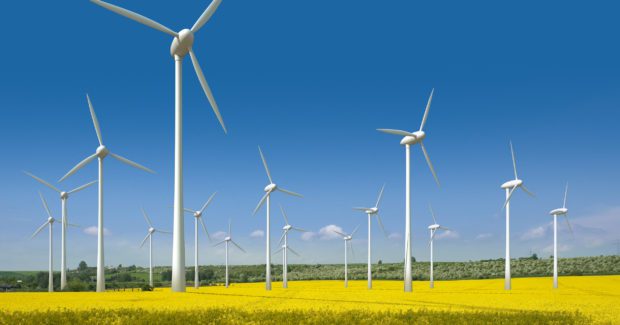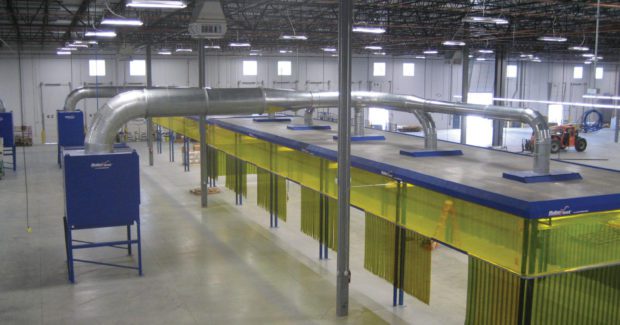Keeping the Green in Green Energy Manufacturing
How clean are your manufacturing processes to build clean energy components? Here are some steps that go a long way towards improving the health and safety of workers in the clean energy industry and reducing the environmental impacts of manufacturing clean energy components.
Posted: October 7, 2016
Cleantech and renewable energy are powering new opportunities for the manufacturing industry. As the U.S. and other countries move towards integration of more renewable energy sources, there will be increased demand for manufacture of solar panels, wind turbines and new infrastructure components. But how clean are our manufacturing processes for these clean energy components? Attention to air quality issues is necessary to keep the green in the green energy revolution.
HOW CLEAN IS OUR CLEANTECH?
Many of the green energy components in highest demand have significant air quality challenges in manufacturing:
- Solar panels are commonly made from a form of silica. During manufacturing, polysilicon wafers are sliced, potentially releasing silica-containing dusts into the air. Uncontrolled silica dusts are a significant health hazard for manufacturing workers, causing serious health impacts such as silicosis, lung cancer, chronic bronchitis and kidney failure. Additional toxic metals and chemicals may also be used during the manufacturing process.
- Competing thin-film technologies reduce potential silica exposures, but rely on compounds containing the heavy metal cadmium, which is both carcinogenetic (cancer-causing) and genotoxic (able to cause inheritable genetic mutations).
- Large metal components for wind turbines or power infrastructure are generally made of stainless steel, and often rely on manual welding due to their large size and irregular shape. Weld fumes from stainless steel contain numerous toxic elements, including hexavalent chromium, manganese and beryllium. However, because of the size of these components, source capture of hazardous weld fumes can be especially challenging: hoods, fume arms and backdraft tables may be out of the question.
- Some manufacturers are moving to carbon nanofiber and other composite materials for elements such as wind turbine blades. However, these materials have their own air quality hazards. Nanomaterials in particular generate tiny particulates when cut or ground that can make their way deep into the lungs and possibly into the bloodstream.
In order to mitigate the health and environmental impacts of fumes and particulates generated during clean energy manufacturing, manufacturers need to have an air quality system optimized for their specific applications and needs.
GOING FOR THE GREEN
There are several steps that clean energy manufacturers can take to reduce their own environmental footprint and protect workers from exposure to hazardous elements:
Choose Filtration Over Ventilation
When working with large components that make source capture difficult, many companies choose a ventilation and makeup air system to pull contaminated air out of the facility and pull in clean(er) outdoor air. However, if your processes result in toxic fumes and particulates containing hex chrome, manganese, beryllium, heavy metals or silica dust, this method may put you out of environmental compliance. It also will result in higher energy consumption if outdoor air needs to be heated or cooled to indoor temperatures. To reduce your environmental footprint, choose a system that captures fumes and particulates and returns clean, filtered air to your facility.
Improve Capture Efficiency
For maximum effectiveness and energy efficiency, you want to capture fumes as close to the source as possible. If you are using robotic welding, make sure hoods are appropriately sized for your application and provide effective containment for welding fumes. For manual welding of smaller parts that can be welded in place, source capture solutions such as fume arms and backdraft tables work well. For large infrastructure and wind components that require welders to move around and over the piece, or for tanks where welders may need to work inside, consider a fume gun. While many welders disliked the heavy, bulky fume guns of the past, newer models now being used are highly effective and only slightly larger than a standard weld gun.
Source capture should be the first line of defense wherever possible; removing fumes at their source reduces airflow and energy requirements, and removes fumes from the breathing zone to protect worker health and safety. If source capture is not possible or practical, an ambient filtration system can be used to continuously clean the air for the whole facility. In this case, workers in close proximity to toxic fumes should have personal protection equipment (PPE). A hybrid system is often the best solution for large, irregular parts and high-production environments – for example, fume guns combined with an ambient push-pull system. (See the nearby chart for more detail on selecting air quality options.)
| Air Quality Solution | Best used for… |
| Hood | Robotic and laser welding applications or high-production manual welding combined with PPE |
| Backdraft/Sidedraft Table | Bench or fixture welding applications with larger parts of fairly consistent size and placement on the bench or fixture |
| Fume Arms | Welding applications for smaller parts that are very size-consistent and remain stationary on the bench |
| Fume Guns | Welding of large pieces that require welders to crawl over the equipment or use lifts or for welding inside tanks or other large components |
| Downdraft Table | Cutting and grinding applications that generate large, heavy particulate |
| Ambient Filtration System | Environments where source capture is not practical or as a secondary system to collect fumes remaining after source capture |
| Ventilation and Makeup Air | Applications that produce low levels of non-toxic dusts and where reheating or cooling to indoor temperatures is not an issue |
Reduce Energy Consumption
The most important thing you can do to reduce energy consumption is to select an air quality option that reduces airflow requirements (see above). But you should also look for energy-saving features in your dust collector, such as high-performance blower wheels and low static pressure designs that reduce the energy required to move air. Variable Frequency Drive (VFD), which automatically adjusts the blower speed to compensate for filter loading, can reduce energy consumption by up to 40 percent.
Reduce Filter Waste
Your system should be configured to maximize filter life and reduce unnecessary waste. First, make sure that your system is designed with proper air-to-cloth ratio (the ratio of filter media to the volume of air being moved). If you don’t have enough filter media for the job, your filters will rapidly become clogged and need to be changed more often. In addition, make sure you are using the proper filter media for your application. Finally, look for features such as vertical filter orientation and automated pulsing to shake excess dust off the filter surface and extend filter life. For example, our Dynamic Pulse system uses a synchronized sequence of pulses to prevent dust re-entrainment on neighboring filters, extending filter life by up to 30 percent to 50 percent.
Dispose of Toxic Particulates Responsibly
Your dust collector will contain collected particulate in a drum or bin for disposal. In many cases, this collected particulate contains toxic elements. When emptying bins, make sure that care is taken to reduce the particulate that ends up back in the air or on nearby surfaces. Workers should wear PPE if they will be exposed to toxic dusts during collector maintenance. Collected particulate should be properly disposed of according to the appropriate environmental regulations.
All of these steps will go a long way towards improving the health and safety of workers in the clean energy industry and reducing the environmental impacts of manufacturing clean energy components. If you’re not sure of the best approach for your processes, an air quality engineer can help you select the best system for your facility. Addressing indoor air quality and outdoor emissions will help you keep your facility clean and green!

















